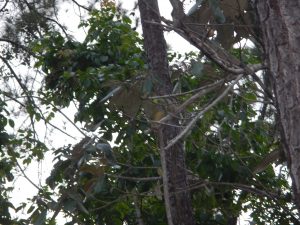The wind was choppy today, but we thankfully still snorkeled right after breakfast. The main goal was to collect a diverse array of species from the back reef to have a little show-and-tell before lunch. And let me tell you- that back reef experience was crazy. Right from the start, Adrienne showed me a baby shark lying down in the seagrass bed. Based on its behavior, it looked like a nurse shark (Ginglymostoma cirratum), but it had spots on its head which made it hard to solidify a classification.
Possible nurse shark in the middle of a seagrass bed
After reaching the reef, it was just piscivorous fish paradise. Yellowtail snapper (Ocyurus chrysurus), mahogany snapper (Lutjanus mahogani), keeltail needlefish (Platybelone argalus), and French grunts (Haemulon spp.) were all in that reef. I also saw a Nassau grouper (Epinephelus striatus) but my camera ran out of juice before I could take a picture of it. Adolpho and Javier also pointed out a scorpionfish to me- it was so well camouflaged that I accidentally took a picture of a rock instead of the fish. After acquiring a decent collection of marine organisms, we went back to the wetlab and presented our specific taxon groups. In relation to fish, there were three crested gobies (Lophogobius cyprinoides) and one damselfish (Stegastes variabilis). Other interesting organisms brought back were the Mantis shrimp, a fire worm, and a baby octopus!
After lunch, Ellie presented on herbivorous fish, I presented on piscivorous fish, and Anna presented on invasive reef species. We then returned the marine organisms to their habitat and analyzed/presented the data from our marine debris collection. SFS, Dory, and Turiez loved it. Because we had such an amazing presentation, they let us do a short snorkel in choppy waters near the patch reef we visited the first day.
Tomorrow is the last full day on this island. It’s kind of weird how slow yet fast time went by- I’m sad to leave but excited for the rainforest coming up.








